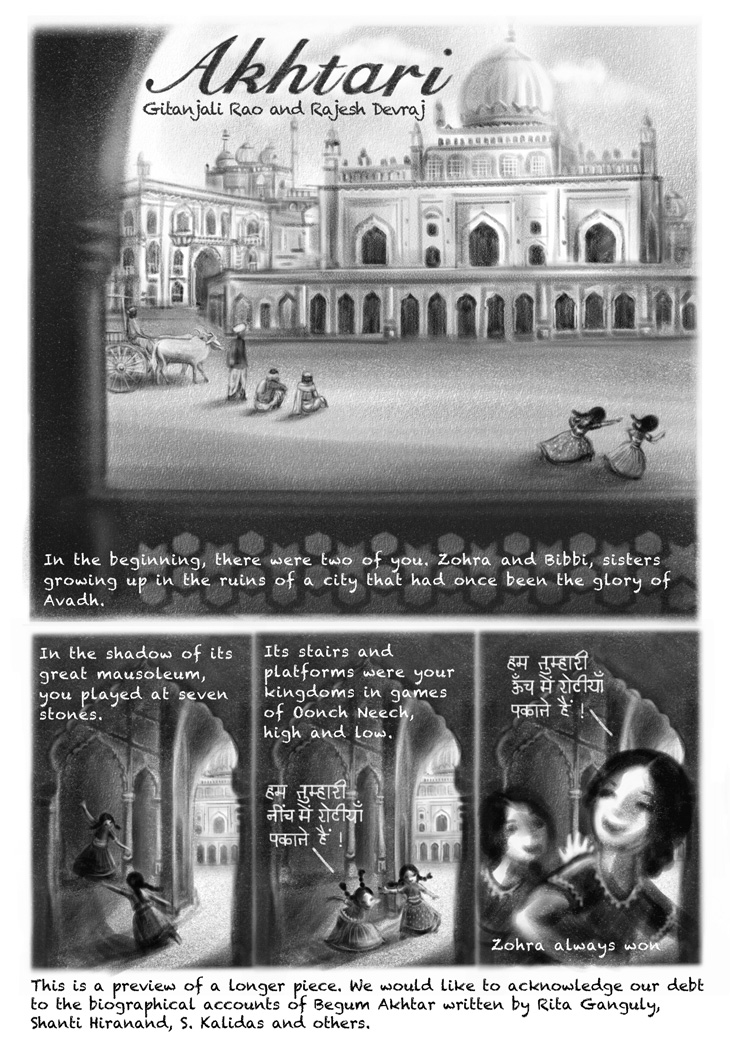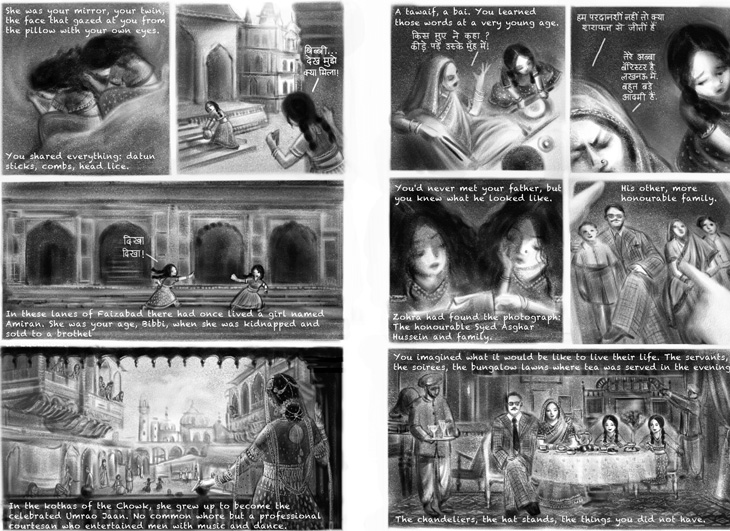Selfies with Frida, sketching Begum Akhtar's childhood - Gitanjali Rao's been there, done that

Clicking selfies with the likes of Che Guevera, Frida Kahlo, Guru Dutt and Smita Patil is 'timepass' for Gitanjali Rao to kill boredom. When she isn't bored, she takes on projects like Akhtari - her retelling of Begum Akhtar's early life - for First Hand, an anthology of graphic non-fiction stories from India.
However, all this is slightly tangential to her original artform - she's actually one of India's most prominent animation filmmakers. Mumbai-based Rao's animated shorts have won multiple awards at Cannes, and she's also been on the Jury at Cannes Critics Week in 2011. Besides this she's won numerous awards across both the international festival circuit and the domestic one.
For the time being though, it's Rao's twin projects which have gained a lot of attention. The first was a set of photographs where she manipulated her image with that of her icons from history and popular culture. She called it 'wishfie.' The other is Akhtari, which is her first shot at the genre of graphic novels. Rao's Akhtari explores the childhood of the famed Faizabad singer and looks at her relationship with her twin sister Zohra, besides capturing Akhtar's formative years as a singer. The anthology First Hand, of which Akhtari is a part, is being published by Yoda Press and will see an end-May release. The first volume will showcase 22 stories.
"Captain Bijli comics and Yoda Press had organised an online competition a year back for graphic non-fiction where they had invited proposals. My friend Rajesh Devraj, also the writer on this, happened to see it online somewhere. He had also seen some sketches of mine of Begum Akhtar from a while back. So he asked me if I wanted to work on a proper graphic novel based on her life. I agreed, we sent in the proposal and collaborated on it subsequently," says Rao.
She's been listening to Akhtar for quite a while but that isn't the only reason Rao chose to tell her story. "For me the period itself is interesting with its tawaiif or courtesan culture. Another interesting aspect is the miniature painting style which I personally have always liked. To tell stories of the time those miniatures were being painted had always been a preoccupation. Begum Akhtar just fit into that whole space in old Faizabad. From the period I was so fascinated with, Akhtar's was the most interesting story I had to tell," she explains.


But what informed her decision to switch to a different form like the graphic novel over animation? Rao says ideally the most attractive format she would prefer for such a subject would be the animated documentary.
"It's the best way to recreate a story when you have all the facts but no footage for the narrative. In fact, making an animated documentary on Begum Akhtar was the first thing which came to my mind," Rao says. But an anima doc will typically involve more resources, funding etc. In comparison, the graphic novel seems much more doable, less ambitious in scale as well perhaps. Also, the chances of reaching out to a younger audience is higher. Rao agrees, "It definitely reaches out to a younger audience. More youngsters would go through a graphic novel than watch a documentary on Begum Akhtar, which in any case would only be seen at festivals, not on television."
How different was the whole creative process, how challenging (or not), for the graphic novel vis-a-vis animation film which is Rao's territory? Rao explains that initially she thought it might be easier but it wasn't. "The main problem is we, as animation filmmakers, learn to tell stories through frames which we control. With graphic novels, that control is lost - the reader can go through whichever part of the page he wants. You have to make the reader go through the page from the top to the bottom or left to right - whatever sequence you want. That's more difficult than you can imagine."
Rao says one illustrator she's keenly followed has been Posy Simmonds (British newspaper cartoonist) but it isn't like she specially prepared before taking up Akhtari. She's an old-timer who has always liked "the classical manner of illustration which was followed before graphic novel became a medium or a thing."
An old-timer, yes. But never old enough to not try something radically new. Like taking selfies.
Selfies? Boring. Time for Wishfies
At 43, Rao may be one of India's foremost animation filmmakers. But she never used a smartphone till three months back. Armed with a Sony Experia, Rao took her first ever selfie on 7 April with the iconic Mexican painter, Frida Kahlo. The series, Wishfies, went viral on social media. Using Photoshop she got herself in the same frame as some of her idols. So, she's looking equal parts intense and quirky with a fat cigar dangling from her lips next to Che Guevera; has her hands around the timeless Smita Patil in one; and, stares purposefully ahead in one photo with Susan Sontag. She's even got one with the Phantom! There's lots more. Check out the whole album here.
"I had a lot of time with no freelance work. Most of the scripts I worked on were being sent to various places for financing. It was one of those phases when you've just finished a creative project, and you don't want to get into another angst-ridden process of creativity!" chuckles Rao.
"Generally any work I do has to have some twist around reality to make it more interesting," says Rao, adding that the thought of taking selfies seems impossible otherwise. "I've always been triggered to do something more than the medium has to offer. I'd be too embarrassed to put up a normal selfie online."
Has the filmmaker in her taken a backseat then? "No, no!" exclaims Rao. She says there's no more selfies in store from her because she's busy storyboarding for her first full length animated feature, Bombay Rose.
"It's a love story between a Muslim boy and a Hindu girl in the streets of Juhu, Mumbai," reveals Rao. The boy is from Kashmir, the girl from Madhya Pradesh. The film also touches upon the politics of shutting down dance bars. The format for the film is something more familiar than the graphic novel to Rao - painted, 2D frame-by-frame animation. There's also some trivia for film buffs - one of the co-producers is Serge Lalou, the same producer behind Waltz with Bashir, the famous Israeli animated war documentary.
Irrespective of what she does - selfies that drip with nostalgia, a graphic novel that sketches a courtesan period, and certainly her films around migration and love- there's a whiff of romance in all projects. Is she a romantic? "Certainly, yes! Whether it's books, films, music... romance has always been a big part of all these experiences for me."
More in Catch:
The GoT dragons were born in Goregaon. But has Indian animation really arrived?
Vincent Van Bot - robots are now taking over the art world
First published: 24 May 2016, 10:49 IST






![BJP's Kapil Mishra recreates Shankar Mahadevan’s ‘Breathless’ song to highlight Delhi pollution [WATCH] BJP's Kapil Mishra recreates Shankar Mahadevan’s ‘Breathless’ song to highlight Delhi pollution [WATCH]](https://images.catchnews.com/upload/2022/11/03/kapil-mishra_240884_300x172.png)

![Anupam Kher shares pictures of his toned body on 67th birthday [MUST SEE] Anupam Kher shares pictures of his toned body on 67th birthday [MUST SEE]](https://images.catchnews.com/upload/2022/03/07/Anupam_kher_231145_300x172.jpg)






